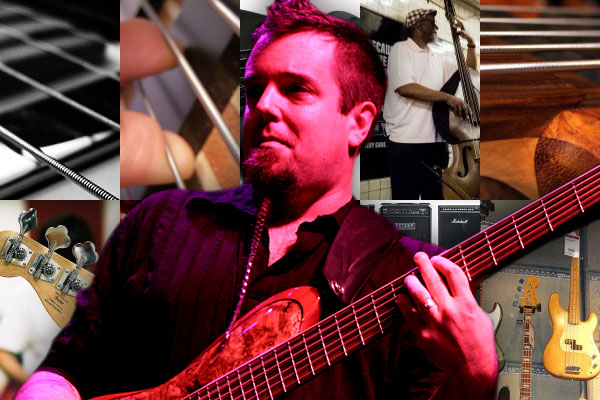Ask Damian Erskine: Mailbag

As readers send in questions, one of three things happens: a) I turn it into an “Ask Damian” column, or b) I respond directly, because the question doesn’t quite warrant an entire column (I do try to respond to everybody) or c) it gets put into the folder of questions that I’d like to answer but don’t know exactly how to build them into a full length column.
This week, I’ve decided to take a handful of the “C” questions and turn them into a collective column for you. Here are a handful of quick questions and answers.
Q: Do 5 string basses have to be made specifically to have a high C instead of a low B? Or can you just get a 5 string that has a low B and shift all the strings down and use the space where the G string would be to put a C string? Also, if that’s possible, would it change the sound or affect anything drastic as far as playability?
A: For the most part, you can simply re-string it and tune it however you like. Often, the nut on a high-end bass is shaped to perfectly fit with a typical set up. You may have read articles about how a properly made nut will cradle the bottom half of the string, leaving the top half exposed. (However, I’m not sure why that is).
Be aware that many lower cost models just have generic nuts that are more about keeping the string from moving, and that’s about it. I’d say that, 9 times out of 10, you could re-string it however you wanted and be fine. There is a slight chance that your strings may sit a bit low in the nut and you may get a buzz. If this is the case, you could try raising the action a little bit or have a new nut made.
For a completely low budget fix, you can do what I did when my old Modulus had an accident before a gig. The drummer accidentally knocked it off of the stand after sound check and it fell forward, landing flat (strings down) on the stage. All was well with the exception of my B string (6-string, fattest string, which is why it hit first). It got pretty well mashed down into the nut and was now too close to the fretboard. What to do right before the gig? I took a small piece of paper, folded it up until it was just a few millimeters thick, loosened the string and placed the paper in between the nut and the string before re-tuning. It worked like a charm! In fact, it worked so well that I continually forgot to fix it and the bass stayed like that for years. I would simply replace the paper every time I re-strung the bass.
In short, you should be fine but you may wind up needing to raise your action just a hair. I’ve messed around with piccolo strings and stringing a 5 string any number of ways and, at the worst, my strings felt a little low when moving to a smaller gauge string.
Q: Is the sound of the finger and string hitting the fretboard acceptable? I’ve just been playing a few years and I’ve been noticing that the sound is pretty noticeable. I also wonder if it is ok for one style of music but not another (like metal vs pop). When NoTreble posts isolated bass tracks, it seems that I can usually hear that sound in there sometimes, too. Should it be considered bad or unclean if I’m making that sound? I also love a fairly muddy sound on the bass but always wonder if the audience would like it as much as I do?
A: There will almost always be some noise when manipulating any instrument. How much noise is acceptable is totally subjective. It’s really up to you, the band leader and/or producer (if in the studio).
Personally, I worked pretty hard to be able to play as cleanly as possible. This became especially true after doing my first recording session and hearing how much extra noise I was making (this included my tendency to lightly thump sub-divisions with my right fingers against the strings).
You’re also right that much of that stuff gets lost in the mix when playing live, and you’ll never not make a little noise when playing or moving your hand against the strings. My advice would be to practice playing with as much control as possible. Try not to make any noise, play cleanly and make sure that every note sounds exactly like you want it to.
Control is really the key to being a good player (good musicianship is a whole other thing, all together but this is a part of it). Indeed, on the few occasions that I’ve played harder music on the bass, I have actually played with more noise on purpose! Attacking the strings a little too hard (in order to get some slap against the frets), hammering notes instead of plucking them, etc… The big difference is that I was choosing how much and what noises I wanted and playing to the music.
As long as you are playing the music as you feel it should be played and the final product is what you hoped, it has to be a least a little right… right?
Again, much of that may change in the studio because things tend to jump out at you, especially in this age of digital recording. When you record analogue, silence has a sound (bit of white noise, really) but when you record digitally, silence is dead silent and everything tends to be a little more exposed. That string and fret noise might be a bit much when listening in the control room. I’d work on controlling it!
Q: I’ve been struggling with my bass playing for a while. I’ve been playing bass for almost 10 years and I think somehow I reached a point where I find it hard to improve. I know my weaknesses and I try to work on them and even with a lot of practice I don’t see any improvement. What do you think it’s the solution for this problem?
A: This question could have been a full column, but I’ve written about this a fair amount, so I didn’t want to be redundant. That said, I would say a few things:
- Improvement is a slow and steady thing. It’s natural to hit ruts and feel like you’re flat-lining with your improvement. Keep working hard and in a focused way with regard to any perceived weaknesses and you will continue to improve.
- Sometimes we just need to switch things up a bit. Work on a new piece of music or explore a new style of music. Personally, I tend to fall back on afro-cuban rhythmic workouts when I get bored or stuck in my development. I’ve always felt that rhythm was the most important thing to me as a musician but I tend to focus on harmony in the shed. A good rhythmic workout never fails to re-ignite a little fire in my playing (and practicing)!
- Make sure that you are also playing music with humans. This goes without saying but one can only improve so much on their own. Music is a team sport (mostly) and the feedback and ideas generated by a group far outweigh time spent in the shed at times. Additionally, getting together with different groups of people will challenge you in new ways. Play with as many people as possible and stretch things stylistically.
- Go see some live music that excited you. I’ve always found my biggest inspiration to come from watching others play.
- Have fun!
Have a question for Damian Erskine? Send it to [email protected]. Check out Damian’s instructional books, Right Hand Drive and The Improviser’s Path.


